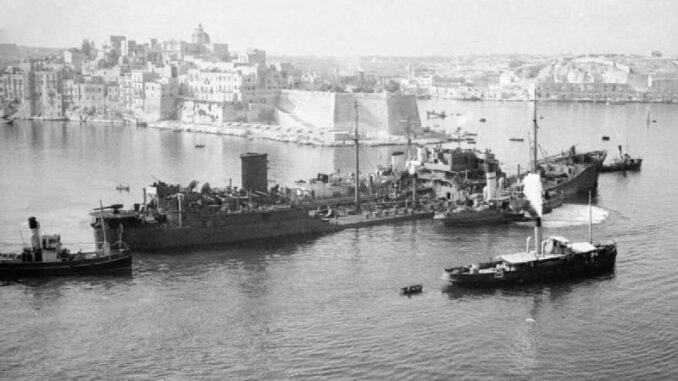
Overshadowed by the European and Pacific Theatres, the Mediterranean Theatre is often overlooked in discussions of the Second World War. However, in 1942, the Allies very nearly lost control of the Mediterranean Sea to the Axis. Had that happened, the Axis would have surely gained control of all of North Africa, including the Suez Canal. Such a strategic loss could have dealt a possibly fatal blow to Great Britain. Without the Suez, Britannia would effectively lose contact with her Indo-Pacific colonies and Commonwealth countries, splitting the Empire in two. Worse, the UK would be cutoff from vital supplies of oil from the Middle East, and rubber from the East Indies, along with many other less-critical commodities. America had just entered the war and was not yet present in force. This is the story of how the Royal Navy and a small squadron of RAF Spitfires – and an American merchant ship – saved the day.
Malta is strategically located in the center of the Mediterranean, halfway between the Strait of Gibraltar and Egypt. The island archipelago was ceded to Britain in 1814 by the Treaty of Paris and became headquarters of the Mediterranean fleet, an especially important location after the Suez Canal was completed in 1869. (Mediterranean fleet headquarters were moved to Alexandria, Egypt, in 1937, when war with the Axis began to appear inevitable and a successful defense of Malta uncertain). Additionally, Malta is about sixty miles south of Sicily and north of Libya, a crucial position considering Libya had become an Italian colony in 1911 and, in the years leading up to the war, Mussolini garrisoned more than 200,000 troops there. This was the beginning of the Axis threat to the Suez.
Italy declared war against the Allies on 10 June 1940, exactly one month after Hitler invaded France. Mussolini may have thought Britain was too busy helping to defend France to send reinforcements to Egypt to defend the Suez. But the 100,000 British troops based in Egypt didn’t need reinforcements and gave the Italian troops a spanking, prompting Hitler to send in the Afrika Korps to avoid an embarrassing Axis defeat.
Winston Churchill recognized the supreme importance of Malta with its excellent harbor and naval base (including submarines and surface vessels) and an RAF airbase. He considered it as an unsinkable aircraft carrier. In an address to the House of Commons, he said, “Its effective action against the enemy communications with Libya and Egypt is essential to the whole strategic position in the Middle East”. In Churchill’s view, the war could not be won if Malta was lost.
The Axis also recognized its importance, as it controlled shipping lanes not only east-west, but also north-south, hampering supply routes between Italy and North Africa. Field Marshall Erwin Rommel, commander of the Afrika Korps, said, “Without Malta the Axis will end by losing control of North Africa”. Capturing Malta, or destroying its ability to project power, became a high priority for German and Italian forces. From June 1940 on, Malta was the target of incessant bombing raids by Axis air forces, and seaborne attacks by Axis navies. The seige of Malta had begun.
Two years later, June 1942, Malta was on the verge of collapse and capitulation. Not a single resupply convoy had been able to reach the island in more than nine months. Small amounts of supplies had been brought in by submarines and fast moving minesweepers, but the Axis had heavily mined the area, and several British submarines, warships, and merchant ships had been sunk or heavily damaged by mines, enemy aircaft, or torpedoes. The most dire need was for fuel. Supplies of petrol for fighter aircraft and diesel for submarines were nearly exhausted. If a convoy including oil tankers didn’t breakthrough soon, Malta would no longer be able to defend itself.
Recognizing the gravity of the situation, in June the Allies sent two large convoys simultaneously, one from Gibraltar and one from Egypt. It was hoped that numbers would overwhelm Axis forces and some ships would get through. Unfortunately, the Axis had broken Allied codes and knew the plan. Both convoys were decimated. The American merchant ship, SS Kentucky, the largest oil tanker ever built up to that time, was lost.
End of part one … to be continued.
Question Of The Night: Warm yellow light bulbs, or bright white florescents in your kitchen?
